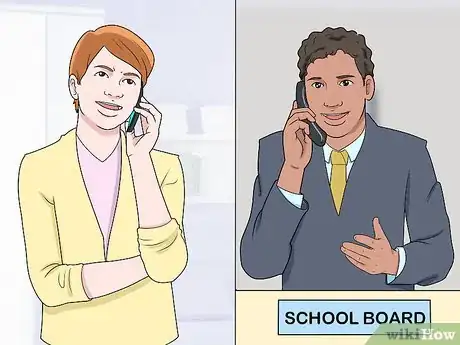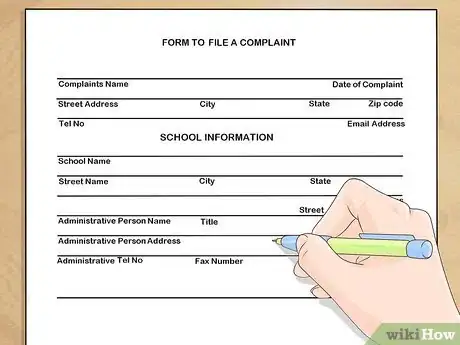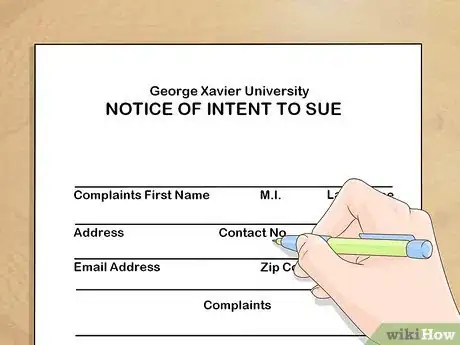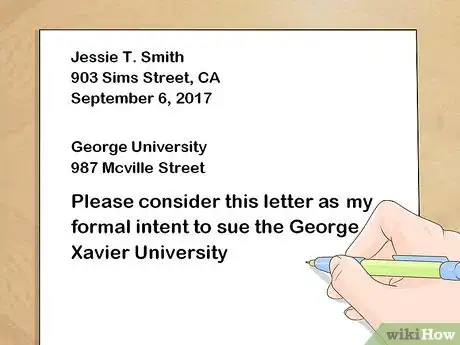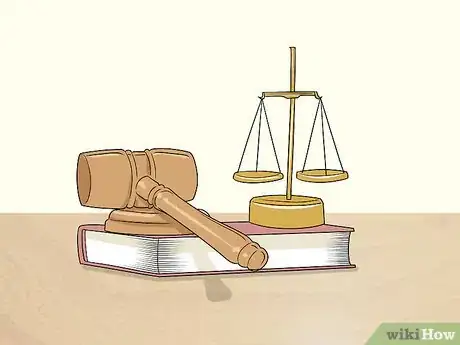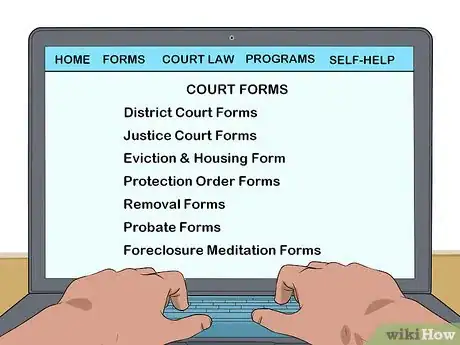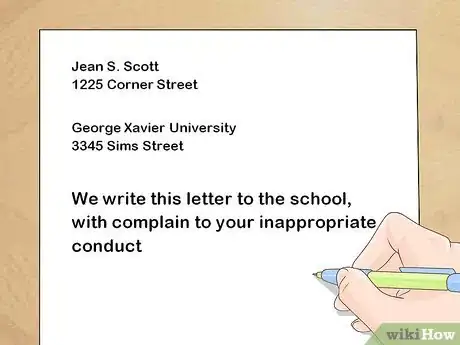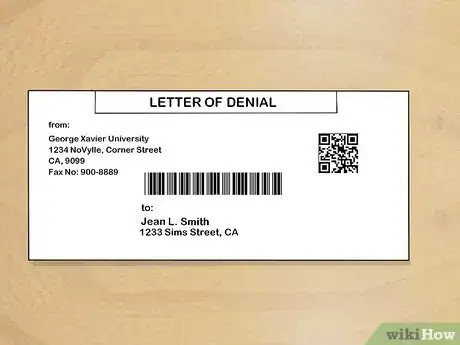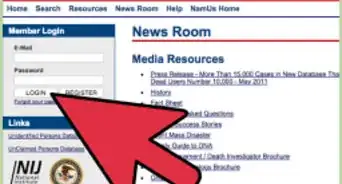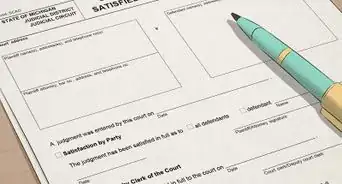This article was written by Jennifer Mueller, JD. Jennifer Mueller is an in-house legal expert at wikiHow. Jennifer reviews, fact-checks, and evaluates wikiHow's legal content to ensure thoroughness and accuracy. She received her JD from Indiana University Maurer School of Law in 2006.
There are 9 references cited in this article, which can be found at the bottom of the page.
wikiHow marks an article as reader-approved once it receives enough positive feedback. In this case, 81% of readers who voted found the article helpful, earning it our reader-approved status.
This article has been viewed 210,393 times.
You may have heard news stories about parents suing the school for something that's happened to their child. The reality is that if your child goes to public school, there are only a few instances where you have the right to sue the school. Even if you can sue the school, you typically have to jump through a few hoops before you can do so. Your best course of action is to talk to an attorney as soon as possible so you follow the right procedure and meet all the deadlines. For cases of administrative failure on the part of the school, you will probably need to talk to a civil rights attorney.[1]
Steps
Exhausting Administrative Remedies
-
1Contact the school board. In most cases, you must work with the school district to resolve any problems before you can file a lawsuit. Check the district's website and look for a phone number or address you can use to file a complaint.[2]
- Most school districts have a specific number for parents or students to call if they have a problem with their school.
- Depending on the nature of the issue, procedures may differ if you are dealing with a private school as opposed to a public school. Talk to the administration at the school or read the school handbook to determine the procedure.
-
2File an administrative complaint. Typically, you must file a complaint or claim with the school district before you can sue a school. Most school districts have a specific form that you can download from the school's website.[3]
- Fill out basic information, including your name, the name of the student, and the name and location of the school.
- Provide a description of what happened, and what you want the school district to do about it. For example, if a teacher discriminated against your child, you would describe what the teacher did and why you felt it was discriminatory. Include as many specific details as possible.
- State what you believe the school district should do about the situation. For example, if a teacher discriminated against your child, you may want the teacher to be disciplined or fired. If your child was injured by a bully, you might want the school to pay for your child's medical bills.
Advertisement -
3Gather documents and information. You will need to provide evidence that the statements you made in your complaint are true. The more evidence you have, the more likely it will be that the school district will rule in your favor.[4]
- If any other students or teachers witnessed the incident, statements from them can be used as evidence.
- You may not have some types of evidence, but know how to get them. For example, if the incident occurred in view of a security camera, you can ask that the footage be taken from the camera and analyzed.
- Photos or diagrams of the part of the school where the incident took place also can be used as evidence. For example, if your child was the victim of a bully, you might use a map of the school to mark where the encounters with the bully happened.
- You'll also need documentation of any damages you've suffered. Include photos of injuries your child suffered, or any medical bills you incurred as a result.
-
4Participate in the investigation. When your complaint is received, the district will undertake an investigation of the incident. They may interview you as well as others who witnessed the incident or who talked to you or your child about the incident.[5]
- At the conclusion of the investigation, the district will let you know what they've decided to do as a result of the incident. If you're not satisfied with the actions taken by the district, you may have the ability to sue the school and the school district at that point.
Providing Notice of Intent
-
1Consult an attorney. If you decide you want to sue a school, you must follow specific steps and meet deadlines that may be very short. If you don’t follow the right steps, your lawsuit may be dismissed – even if you had a valid complaint.[6]
- Finding out exactly what you need to do will require a lot of research, and you may overlook something. While you don't necessarily need an attorney, working with one can save you a lot of hassle. An experienced education or administrative law attorney will already know all of this information and be able to help you navigate the system.
- An experienced attorney can also analyze your case and give you their thoughts on whether you have a chance of winning in court. If you talk to several attorneys and they all say you're unlikely to win, you may want to reconsider your lawsuit.
-
2Identify your cause of action. The cause of action is your reason for suing the school. You can only sue the school if you can point to something the school did that violated the law. This can be difficult with public schools because they are considered part of the government, and are immune from many lawsuits.[7]
- Government immunity doesn't mean you can't sue the school, but the reasons you can sue are extremely limited.
- For example, if your child falls down and gets injured in the lunchroom, you typically can't sue the school. Schools can't be sued for simple negligence. However, if your child suffered heat stroke because they were forced to run outside on an excessively hot day, you may be able to sue.
- Generally, your cause of action will be based on some intentional act on the part of teachers or administrators. Most often, lawsuits against a school are related to the violation of a child's constitutional rights.
-
3Look for notice of intent forms. In most cases, if you're going to sue a public school, you must first send the school or school district a notice of intent to sue and give them an appropriate amount of time to respond, typically 30 days.[8]
- Many school districts have a form you can use for your notice of intent to sue. Using the form can save you some trouble and also ensure that you have all the information that is legally required to be in the notice.
-
4Draft a notice letter, if a form isn’t available. If you can't find a form to use, you may have to draft a letter yourself. This should be a formal letter that details your cause of action and states that you intend to sue the school for that reason.[9]
- Typically, you also must cite the law or policy that you believe the school has violated.
- If you can't find a form, it may be in your best interest to get an attorney to draft the letter for you.
-
5Send your letter to the school. Mail your letter to the school using U.S. certified mail with return receipt requested. That way you'll get a postcard in the mail when your letter is received. You'll need this postcard later to prove to the court that you sent the school your notice of intent to sue.[10]
- Without this proof, your lawsuit may be automatically dismissed. When you get the card, put it in a safe place.
Filing a Complaint
-
1Choose the correct court. You must file a lawsuit in a court that has jurisdiction over the school and the incident that took place. Typically this will be a court in the same city or county where the school is located.[11]
- You also must choose between state or federal court. In most cases, you'll file your lawsuit in state court. However, if your lawsuit is based on federal law or on a violation of constitutional rights, you also have the option to file in federal court.
- If you have questions about jurisdiction, you may want to talk to an attorney. Someone in the court clerk's office also may be able to help you, but they can't give you any legal advice and may be limited in what they can tell you.
-
2Check with the court for complaint forms. Many courts have fill-in-the-blank forms available for people to use who aren't being represented by an attorney. If you've decided not to hire an attorney to file your lawsuit, look for forms on the court's website.[12]
- You may also be able to find forms by going to the courthouse and talking to someone in the clerk's office.
- If you can't find forms, look for example complaints filed in other cases that you can use as a guide. That way you can make sure your complaint is formatted correctly and that you have all the necessary documents and information.
-
3Hire an attorney. You aren't legally required to hire an attorney to represent you when you sue a school. However, hiring an attorney will save you a lot of time and trouble. Since an attorney already knows the exact procedures to follow, you can be sure that you won't inadvertently violate court rules and get your case thrown out.[13]
- Look for an attorney that has experience suing schools and school districts. Ideally, you want someone who has experience filing cases similar to yours.
- Interview several attorneys and ask them lots of questions about their experience and methods.
-
4Draft your complaint and summons. The complaint is the legal document that officially starts your lawsuit. The summons tells the school (or the school's representative) that they are required to appear in court and answer your lawsuit.[14]
- A complaint is a formal document that lists the facts of your case (what happened). It also states that these facts add up to a violation of the law, and that you are entitled to some form of relief as a result.
- You'll explain what you want the court to do. You could be asking to be compensated monetarily, or you could want the court to order the school to act in a particular way. For example, if your child was kicked off the soccer team and you believe it was due to racial discrimination, you may want the court to order the school to allow your child to play on the soccer team.
-
5Take your complaint to the clerk of court. File your complaint with the court to initiate your lawsuit. Bring along your original documents plus a couple of copies. To file your complaint, you'll have to pay a filing fee – typically several hundred dollars.[15]
- If you can't afford the filing fee, you may be eligible for a waiver. Ask the clerk for details.
- Once you file the complaint, the clerk will stamp the originals and keep them for the court. They'll also stamp the copies and return those to you. One of the copies is for your records. The other copy you will have to send to the school using a particular method called service of process. Typically, this means paying a small fee to a sheriff to deliver the documents.
-
6Receive the school's answer. When the school receives your complaint, they have a limited period of time to respond, or you could win your lawsuit by default. However, you shouldn't expect that the school will fail to reply.[16]
- In most cases, the school will submit a written answer denying most, if not all, of the allegations in your complaint. They may also file a motion to dismiss.
- The school and the school district will always have a team of attorneys. For this reason, if you haven't hired a lawyer yet, now is a good time to do so. If you represent yourself, your case may not survive a motion to dismiss.
- On the other hand, the school district may decide not to fight your lawsuit and offer a settlement instead. Consider the settlement carefully. You may want to get an attorney's advice on whether you should accept it.
References
- ↑ http://blogs.findlaw.com/injured/2013/04/how-do-you-sue-a-school-district.html
- ↑ http://statelaws.findlaw.com/california-law/how-to-sue-a-school-in-los-angeles-for-injuries.html
- ↑ https://www.legalmatch.com/law-library/article/how-to-sue-a-school-district.html
- ↑ https://www.legalmatch.com/law-library/article/how-to-sue-a-school-district.html
- ↑ https://www.legalmatch.com/law-library/article/how-to-sue-a-school-district.html
- ↑ http://www.alllaw.com/articles/nolo/personal-injury/sue-school.html
- ↑ https://www.legalmatch.com/law-library/article/how-to-sue-a-school-district.html
- ↑ http://statelaws.findlaw.com/california-law/how-to-sue-a-school-in-los-angeles-for-injuries.html
- ↑ https://www.nolo.com/legal-encyclopedia/can-school-district-be-sued-injuries-students.html
- ↑ https://www.nolo.com/legal-encyclopedia/can-school-district-be-sued-injuries-students.html
- ↑ https://www.freeadvice.com/legal/jurisdiction-and-venue-selecting-the-right-court/
- ↑ http://www.civillawselfhelpcenter.org/self-help/lawsuits-for-money/pleading-stage-filing-a-complaint-or-responding-to-a-complaint/241-filing-a-complaint-to-start-your-case
- ↑ https://law.freeadvice.com/government_law/education_law/school-bullying-do-you-need-an-attorney-to-file-a-claim-against-a-school-district.htm
- ↑ http://www.civillawselfhelpcenter.org/self-help/lawsuits-for-money/pleading-stage-filing-a-complaint-or-responding-to-a-complaint/241-filing-a-complaint-to-start-your-case
- ↑ http://www.civillawselfhelpcenter.org/self-help/lawsuits-for-money/pleading-stage-filing-a-complaint-or-responding-to-a-complaint/241-filing-a-complaint-to-start-your-case
- ↑ http://www.civillawselfhelpcenter.org/self-help/lawsuits-for-money/pleading-stage-filing-a-complaint-or-responding-to-a-complaint/243-responding-to-a-complaint-if-you-ve-been-sued
About This Article
To sue a school, first decide if you have reasonable grounds to sue, such as the school violating your child’s constitutional rights. Gather any evidence you have of the offense, such as staff and student statements, copies of emails, and photos. Consider hiring an attorney to help you file the lawsuit, since a lawsuit is a lot of work. If you have a strong case, provide the school with a notice of intent to sue and wait 30 days for their reply. Then, provide your state or federal court, depending on the offense, with your complaint to initiate the lawsuit. You’ll also need to provide the school with a court summons. Wait for their response, since they may decide to settle out of court or fight the lawsuit. For more tips from our Legal co-author, including how to use a pre-made court complaint form to save you time, read on!
